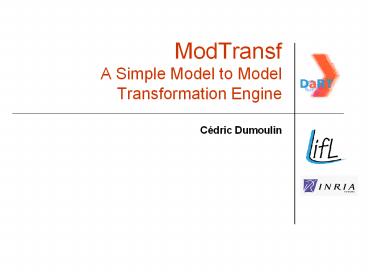ModTransf A Simple Model to Model Transformation Engine PowerPoint PPT Presentation
1 / 30
Title: ModTransf A Simple Model to Model Transformation Engine
1
ModTransfA Simple Model to Model Transformation
Engine
- Cédric Dumoulin
2
Requirements
- Model input
- XMI files, ruled by a MOF metamodel
- XML files, ruled by an XML schema
- Easy maintenance of transformation rules
- To follow metamodel changes
- Code generation from model
- Simple to use
- Yet available
3
Proposed Solution
4
Proposed Solution
- A transformation engine
- takes model(s) and set of rules as input,
- and produce model(s)
5
Vocabulary
- Model
- Graph of related Concepts
- Concepts defined in metamodel
- Metamodel (MM)
- Graph of classes defining concepts
- Transformation
- Specify how concepts from input MM are mapped to
concepts of output MM
6
Basic Principle
- Divide and Conquer
- Express transformation rule by rule
- Rule
- Specify how one or few input concepts are
transformed to one or few output concepts.
r1
r2
r3
r4
r5
T
input MM
output MM
7
Rule
- A rule is made of
- domains
- describe input and output concepts
- can contain complex conditions
- implicitly define enterGuard, exitGuard, concept
creations - implicitly define rule parameters
- enterGuard
- to guard the rule execution
- actions
- to populate concept, perform code generation, do
additional computation, - exitGuard
- to check the result
- bind variables
- to bind concept and properties to guards and
actions
8
Rule Example 1 (UML)
9
Rule Example 1(XML)
10
Rule Example 2 (UML)Nested Concept
11
Rule Example 2 (XML)
12
Transformation
- A transformation is made of
- involved models declaration
- rules
- topRule
- called by the engine
- execute all possible solutions on input domains
- rule
- called by other rules
- selectRule
- set of rules called by other rules
- the first matching rule is executed
13
Transformation (UML and XML)
14
How Transformation is Processed
- Called with input and output models
- Specify which models are used as target
- target models are usually empty
- models are bind to transformation model names
- TopRules are executed
- input domains are those referring to input models
- output domains are those referring to output
models
15
How Rules are Processed
- Input bind variables are set
- Input enter guards are checked
- stop if not verified
- Output actions are executed
- Output objects are created and populated
- starting from the more nested one (leafs)
- For a concept, property values are computed
first, then the object is created and populated. - Output post actions are executed
- Output exit guards are checked
16
Multiple Call of a Rule
- Call of a rule with the same set of parameters
- Return the same result
- Only the first call is executed
- Subsequent calls return the first result
- ? multiple properties referencing the same
concept are transformed to references to the same
transformed concept
17
Advanced Features
18
Extra Properties Definition(ex stereotypes)
- Extra Properties can be defined on model concepts
- Usage like regular properties
- Only visible in the transformation
- Example
- definition of the property stereotypes
- used to check stereotype
- defined by the model helper
19
Extra Properties Usage
20
Code Generation
- Associate code templates to rules
- Templates contain
- Replacement places for attributes
- Nested rule calls
- Use Velocity templates
c1.packageName foreach( import in c1.import
) import import end public class c1.name
// attributes engine.callRule("attribute,
src.feature) // methods engine.
callRule( method, src.method)
21
Code Generation Example
22
Documentations
23
- Ongoing effort
- Schema
- modtransf-v3
- XML syntax
24
XML Rule SyntaxSchema (transformation)
25
XML Rule SyntaxSchema (domains)
26
Access To Models
- Throw a common API
- Should be implemented for each Technology
- JMI, XML, EMF, Database,
27
Models Kind
- Engine takes graphs of objects as models
- Model loading is not part of the engine
- Can use JMI, JAXB, Castor, DOM,
- From MOF metamodel
- Use JMI
- From XML schema
- Use JAXB, Castor
28
Future features
- Aspect like property declaration
- enable declaration of extra properties and
methods on model concepts - Structure and classes declaration
- To create data needed during transformation
- dependsOn
- Allows specification of rule dependencies
- Inheritance
- Key declarations
- To lookup created concepts by specified
properties
29
Questions and Discussion
30
(No Transcript)

